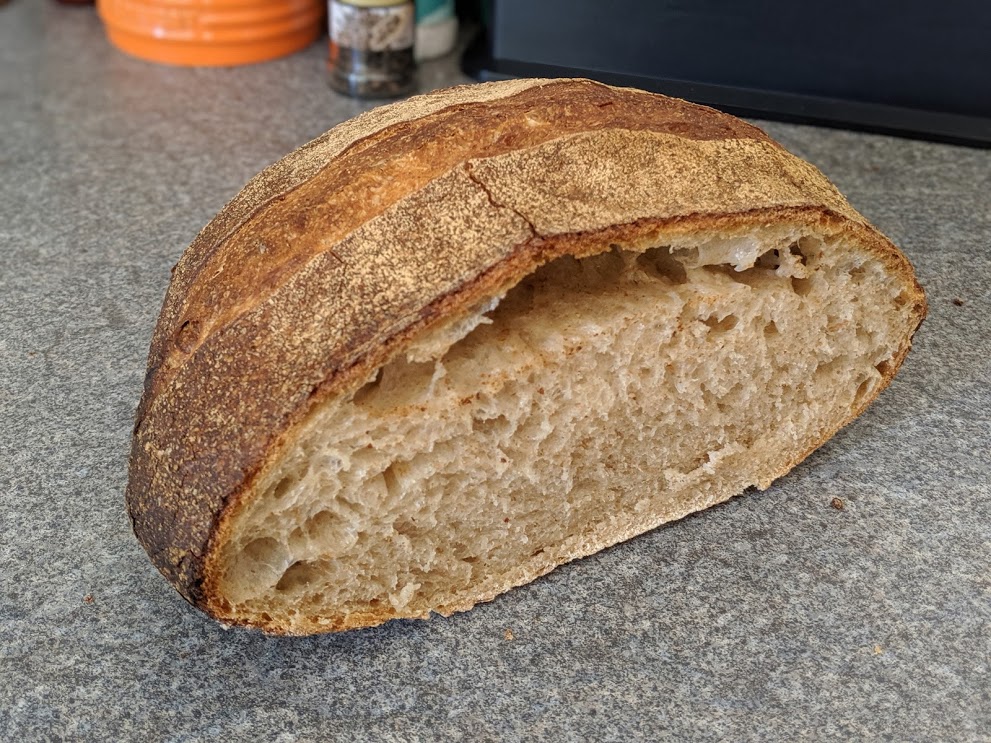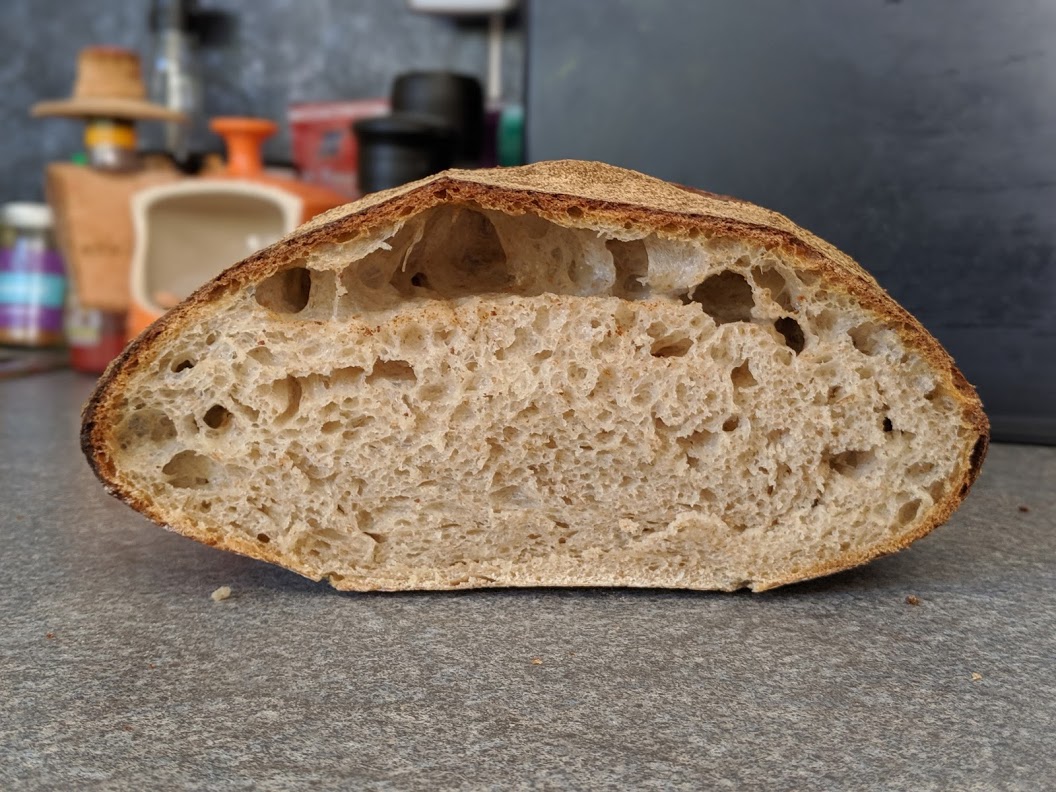Morning Folks,
Long-time browser, first-time poster. I've recently started making Sourdoughs after getting fairly consistent with my yeasted bread, and I'm struggling with a few (possibly related) issues.
My scores "open", but don't form an ear, the crust is also very thick, and a substantial cave forms underneath. The loaf also lifts at the edges, creating tension/stretch marks around the edge.


I'm using the fairly standard "Tartine" method, which is a 75% hydration dough, 45 minutes autolyse, 5 hours bulk ferment with regular folds, bench rest, pre-shape, the final shape and then slapped into a cloth-lined banneton overnight in the fridge. It then warms slightly at room temp before going into the oven. It's baked at about 450F, on a stone with a pan of water to steam for around 45 minutes.
Is the crust perhaps baking too quickly? I've tried additional steam and dropping the oven temp by 20 degrees, but it yielded pretty much identical results.
The bread tastes great but I look forward to ironing out these issues.
Robert
My first reaction is that the temperature on the top is much hotter than the bottom. Do you let the oven preheat for a while or do you stick in the loaf as it reaches temperature? If the latter, keep in mind that it takes the stone a while to reach oven temperature, so it may be too cool for your bake.
Sorry, forgot to mention another likely reason this is happening is that your dough is too cold when you put it in the oven from the fridge. It should be close to room temperature through and through before going in the oven. That could take an hour or two or more. For your second attempt, I would try not retarding overnight but to bake after proofing. Something tells me everything will resolve.
@wheatbeat - Thanks so much for the suggestions.
I only preheat the oven for about 30 minutes, and the loaf is likely still a bit chilled before it goes in to bake. I'll try increasing that time and hopefully, it'll help.
If I choose not to retard overnight, how long a proof would you give at room temp? I know there is no firm answer to that, but are we talking 1-2 hours or something like 4-5?
If we are talking Tartine then I believe it is 100% sourdough and no commercial yeast. It needs a long proof. The exact time depends on how the dough behaves at your temperatures and other factors. I would start with 2 hours and then see. In case you aren't familiar, a good way to check if it is proofed properly is to gently press your floured knuckle into the dough about 1cm. If it stays indented then you are over-proofed, get it in the oven ASAP. If it slowly springs back then you are fully proofed, get it in the oven. If it springs back quickly, it needs more time, wait a half hour and try again.
Hope that helps...
Sounds like very sensible advice. I'll be baking another loaf tomorrow, so I'll report back with the results.
Thanks again.
Yes, hearing how things went will be great!
My loaves go straight from the fridge to the oven, so I would not worry about this.
I’ve had this problem only once, with a multigrain bread. My guess is that shaping might be an issue. Are you bursting possible gas bubbles that form during the stretch and folds? The cave provably means that there was a high concentration of gas around that area. The crumb does not look overly dense. Six hours in room temperature seems fine, provided it is warm enough (I usually bulk for 5h at 25C and 20% levain).
As planned I baked another loaf today.
I took the initial advice and pre-heated the oven an extra 30 minutes, and also proofed the bread at room temp for 2ish hours rather than straight from the fridge.
Unfortunately I got the same results.
So I guess the issue is somewhere else in my process. I'm going to try and be firmer with my shaping, and de-gass the dough slightly next time.
I have noticed that the loaf seems to splat when first going on the stone in the oven, and then gets its rise, maybe that's related?
Really appreciate the insights.
Usually, if the loaf collapses when you move it, that is a good sign it is over-proofed. 2 hours for a sourdough is not much, but maybe your kitchen is warm? I would also consider re-visiting if there is a strong temperature difference between top and bottom of your oven. Maybe consider your next attempt in a dutch oven to rule that out and some other factors?
Yeah, the loaf did have that slight jelly-like "wobble" which I'd associate with over-proofing, however, my kitchen is only around 20C, and as you say, the proof wasn't very long. Could the 5-hour bulk be too long/short, so strength doesn't develop properly?
Another factor which sprung to mind last night is my flour mix is 400g Strong White Bread and 100g Strong Wholemeal Bread- should the wholemeal perhaps be standard flour rather than a strong white, to stiffen up the dough a bit?
So I've done a few experiment loaves over the past couple of days trying both shorter (2 hr) and longer (4hr( proofs with pretty much identical results.
The loaf billows up nice and large, while proofing and in the oven, to the point that it's almost like an inflated pita bread, which strange shapes and stretches around the side.
I also tried being a little firmer with the shaping, and even shaped my last attempt twice, with a 20 minute rest.
The dough almost seems to liquify when proofing, and becomes very wobbly and jelly like.
Any other suggestions in what to try?
I'd really suggest the dutch oven method for your next attempt to rule out oven temperature and steam issues which could all be contributing to your problem. If you get this result using the dutch oven, then at least we know it almost certainly has to be something with your process.
Also, it does concern me that your dough feels like jello when it is going into the oven. Something there is not right. My best guess is that you are over hydrated. What flour are you using? In any case, I would also consider reducing your hydration. Formulations should be a guide only, you need to feel your dough and adjust accordingly. You seem to be too wet.
Sure thing! I'll give that a shot and let you know how I get on. My yeasted breads are usually fine so don't expect oven temps are a huge issue, but maybe the higher hydration makes the difference.
Appreciate your help.
Yeah I have a feeling about hydration too - I'm in the UK and I've read our flour isn't great.
I plan to try a batch with lower hydration - and pick up some extra strong Canadian flour.
So I picked up some Canadian flour and the difference is night and day!
Even during the bulk ferment the dough felt so much better than before.
The final loaf is by no means perfect, but much better, no more uneven crumb or huge void in the top of the loaf.
I'm going to bake some more, but pretty sure that the standard UK bread flour just can't handle the 75% hydration
Thanks so much to all the advice.